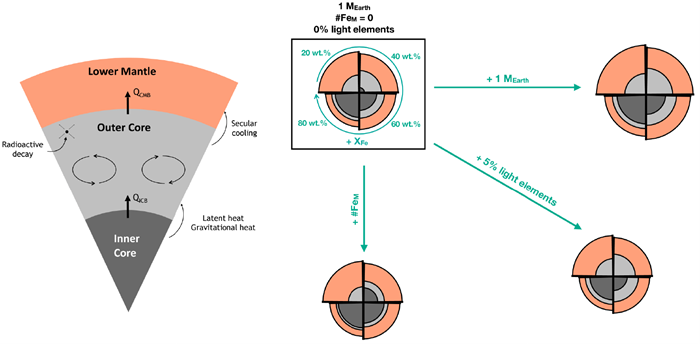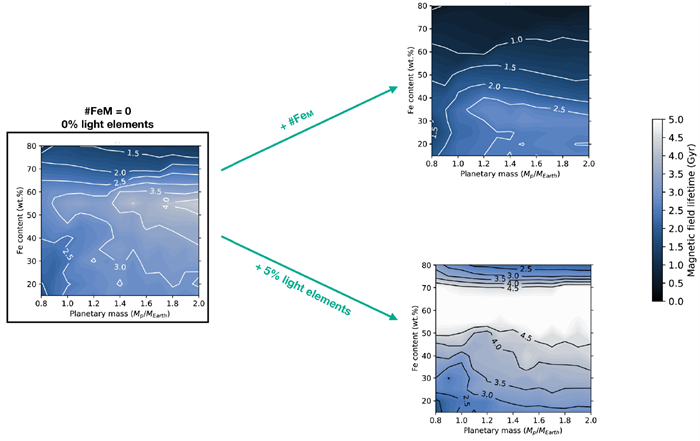Large-scale magnetic fields of rocky planets may offer unique windows into the structure, dynamics, and thermal history of their deep-seated cores. In a new study published in JGR: Planets, Irene Bonati et al. investigated the structure and the evolution of the cores of rocky planets having different masses and iron contents. The research team found that the iron inventory and its distribution between the core and mantle strongly influence core growth and the lifetime of the generated magnetic field.
The Earth’s core is arguably the most hostile environment of our planet, featuring extreme pressures and temperatures. However, despite its hellish conditions, the core is also the source of a feature that may have helped our planet to sustain habitable surface conditions over long timescales by protecting the atmosphere from harmful solar radiation – the magnetic field. For Earth and other planets, magnetic activity is (or was) likely powered by vigorous convection in the liquid portion of the core, an outer shell of molten iron which surrounds a solid metallic sphere, slowly growing as our planet cools. Being generated in the deep interior and manifesting in the upper layers of the atmosphere, magnetic fields offer a unique window to a planet’s deepest interior. The presence (or absence) of magnetic activity may also contribute to the elevated degree of diversity observed for many exoplanets discovered to date.
To this purpose, ELSI affiliated scientists Irene Bonati (former ELSI PhD student) and Marine Lasbleis (LPG Nantes), along with Lena Noack (FU Berlin), used computational models to study the structure of exoplanetary cores after accretion and to assess the feasibility and lifetime of magnetic activity. They conducted a parameter study by analysing planets having various masses, iron contents, and core compositions. By considering a thermal profile of the mantle that is consistent with the end of a magma ocean stage (i.e., an extreme mantle melting event attributed to the occurrence of giant impacts), they found that early solid inner cores are common for rocky planets in the aftermath of accretion (Figure 1). Interestingly, inner core fractions do not strongly depend on the planetary mass but rather on the temperature at the core-mantle boundary (CMB) and the core composition. The former parameter is affected by both the iron content (i.e., the core mass fraction) and its distribution between mantle and core (the mantle iron number #FeM), while the latter is influenced by the fraction of light impurities in the core - oxygen, silicon, sulfur, carbon, and hydrogen – that depress its melting temperature. As a result, planets with high iron contents and mantle iron numbers, as well as iron-rich cores, tend to feature larger solid cores.

The same parameters become important when considering the evolution of the core and the longevity of the generated magnetic field. As shown in Figure 2, planets that are either very iron-rich or have large mantle iron numbers, or both, tend to have shorter magnetic field lifetimes. This is either due to the full solidification of their (initially larger) cores or to a drop in the CMB heat flow (or both) to a point below which convection in the liquid portion of the core is inhibited. To an extent, the magnetic field lifetime can be extended by the presence of light elements in the core, but the fraction and the nature of these light impurities needs further study.

This work brings us a step closer to understanding how core structure and magnetic activity are affected by different parameters and can even provide exciting clues regarding the evolution of rocky planets in the solar system. For example, a high mantle iron content, hypothesised for Mars, may explain why the planet does not have a presently active magnetic field. Things become much more complicated for exoplanets where the planetary mass and radius alone, currently provided by exoplanetary observations, are insufficient for constraining internal structures and thermal histories (Figure 3). Studying the interaction of internally generated magnetic fields with the atmosphere will offer the possibility of constraining interior properties starting from future atmospheric observations. There are, of course, many other questions on planetary cores that are left unanswered: does an inner core start freezing from the centre for all types of rocky planets? Is the liquid core fully mixed? How does the core evolve in the presence of a (partially) molten mantle? Hopefully, some of these mysteries are going to be revealed in the following years.

| Journal | Journal of Geophysical Research: Planets |
| Tile of the paper | Structure and thermal evolution of exoplanetary cores |
| Authors | Irene Bonati1*, Marine Lasbleis1,2, Lena Noack3 |
| Affiliations | 1. Earth-Life Science Institute, Tokyo Institute of Technology, Tokyo, Japan 2. Laboratoire de Planetologie of Geodynamique, CNRS, Université de Nantes, Université d'Angers, Angers, France 3. Department of Earth Sciences, Freie Universität Berlin, Berlin, Germany |
| DOI | 10.1029/2020JE006724 |
| Online published date | 15 April, 2021 |
